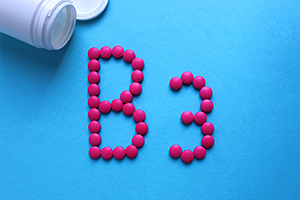



| By Dr. Ronald Hoffman
I’m in the business of knowing which supplements will make the grade—for patients and my listening and reading public. I’m constantly inundated with product pitches, few of which really pan out. To maintain the credibility of my recommendations, I perform a lot of due diligence.
 I’m constantly on the lookout for the next CoQ10, curcumin, or resveratrol—tried-and-true nutraceuticals which have deservedly revolutionized the health marketplace.
I’m constantly on the lookout for the next CoQ10, curcumin, or resveratrol—tried-and-true nutraceuticals which have deservedly revolutionized the health marketplace.
To make the grade, products have to fulfill these criteria:
Nicotinamide riboside has satisfied these requirements for me.
Nicotinamide riboside (Niacel) is a newly-researched vitamin B3 analogue that is an efficient precursor to NAD+ (Nicotinamide adenine dinucleotide). NAD+ is a key component of the body’s energy cascade. Like CoQ10 (ubiquinone), it is ubiquitous in all the cells and organs of the body. It declines with aging, physical deconditioning, and disease states. It is essential for efficient energy output of the mitochondria, the powerhouses of the cells.
The quest for a supplement to augment the body’s NAD+ levels began in the 90s when a product called “Enada” was introduced. Touted as an energy booster and as a remedy for Parkinson’s Disease, it enjoyed brief popularity. But I recognized early on that the reduced NADH it consisted of had little chance of surviving digestion, and thus of impacting performance. It has since faded from the marketplace.
But nicotinamide riboside is the real deal. Here’s where I think it has potential:
Healthy aging. In a study performed at Lausanne University in France, researchers found that by administering nicotinamide riboside to elderly mice they achieved restoration of their organs’ ability to regenerate as well as enhanced longevity. Nicotinamide riboside works on the sirtuin pathway that is revved by caloric deprivation and resveratrol. It offers an alternative to draconian food deprivation as a way of extending lifespan. It appears to revitalize stem cells so they can execute repair functions within the body.
Neurological disorders. The application of nicotinamide riboside to a wide array of neuro- degenerative conditions is now the subject of intense research: Parkinson’s Disease, multiple sclerosis, optic neuritis, peripheral neuropathy, post-stroke, traumatic brain injury (TBI), sudden-onset hearing loss, and Alzheimer’s Disease. What these disorders have in common is that they represent varying degrees of mitochondrial dysfunction in high-energy demand neurons. Restoration of mitochondrial efficiency offers a plausible avenue of improvement.
Metabolic conditions. Metabolic syndrome with associated obesity is a pathway to diabetes and atherosclerosis, making it the world’s most pervasive cause of preventable premature death. Inefficient energy expenditure is implicated in metabolic syndrome, making nicotinamide riboside a likely candidate to ameliorate it. Indeed, animal studies show that nicotinamide riboside prevents obesity in fat-fed mice; it also reduces insulin resistance, prevents fatty liver, lowers cholesterol and LDL without diminishing HDL, and enhances thermogenesis and endurance. Its effects in this regard are similar to those of resveratrol, which also acts on sirtuin pathways.
Fatigue states. NAD+ is one of the body’s premier energy molecules; deficiencies of NAD+ production are characteristic of aging and debilitation. Many researchers suspect that chronic fatigue syndrome and fibromyalgia are, at least in part, disorders of mitochondrial metabolism. Nicotinamide riboside is a likely candidate to join such supplements as magnesium, B vitamins, CoQ10, l-carnitine, NT Factor, d-ribose, and PQQ as plausible mitochondrial facilitators.
Athletic performance. There’s every reason to suspect that nicotinamide riboside could be an aid to athletic performance. First, it enhances mitochondrial energy output, which should translate to improved strength and stamina. And second, it could ameliorate delayed-onset muscle soreness (DOMS), which places a ceiling on training intensity. Unfortunately, human studies are lacking, but I feel my endurance has improved since I began taking it.
Cancer. No one is saying that nicotinamide riboside is a panacea for cancer. But studies raise the intriguing possibility that it may shield DNA from the cumulative damage that leads to cancer mutations. Ina mouse model of liver cancer, animals were protected from tumor development by nicotinamide riboside. More research needs to be performed to see if these results are applicable to humans.
A word on dosing. How much nicotinamide riboside does one need to take to obtain benefits? A 2015 study showed a single 100mg dose of NR was effective in raising NAD+ levels by 30%; 300mg and 1000mg dosages showed a 50% increase in NAD+ levels. The increase in NAD+ levels were longer lasting at the higher dosages. A longer term study of NR taken daily for eight consecutive weeks is underway to measure NAD+ increase from NR and to determine the most effective dosage.
The issue of optimal dosing came up in a recent podcast I did with Guy Daniels, an expert on nicotinamide riboside. The product Niacel by Thorne Research is available as 125 mg capsules. Initially, it was suggested that customers take one capsule twice daily; for many, that wasn’t enough. At Guy’s suggestion, after upping my dose to two capsules twice daily (500 mg), I began to notice a difference.
Therefore, I would suggest a two-week trial of that dose, which works out to one bottle of Niacel (60 caps). If you don’t experience subjective benefits in energy or performance after two weeks, then you may be a non-responder. Of course, that doesn’t preclude the possibility that you might still garner long-term anti-aging benefits from nicotinamide riboside which aren’t reflected in an immediate pep boost. (Thorne plans to release a higher-dose nicotinamide riboside 250 mg to achieve the daily target of 500 mg with fewer capsules.)
Additional references:
Mitochondria and Aging: ‘Remarkable’ Effects for Nicotinamide Riboside in Mice, Says New Study
Vitamin Supplement Successfully Prevents Noise-Induced Hearing Loss
Though we think of declining estrogen as the hallmark of menopause, it's actually common for…

Up to 12 percent of Americans have ulcers at some point in life. Peptic ulcers…
Gallbladder disease is a modern illness. An estimated 20 million Americans have gallbladder disease. The…

This past week we were regaled with headlines like: High levels of niacin may increase…

March is National Nutrition Month and, needless to say, good nutritious food is essential to…

I recently attended the Integrative Healthcare Symposium (IHS), an annual conference held here in Manhattan. The…

The Profit Motive Behind American Dialysis with Tom Mueller, Part 1

Our virtual voicemail is open 24/7, so there's no need to wait to submit your questions for Dr. Hoffman. Leave a message, and you may hear your question featured on the Intelligent Medicine radio program!